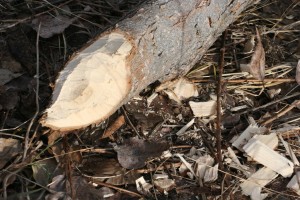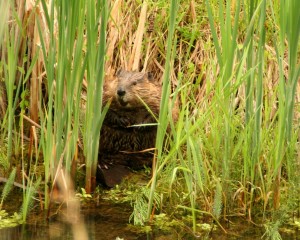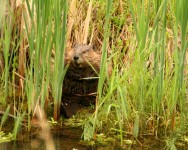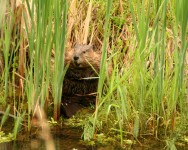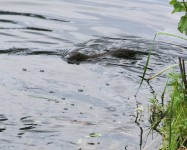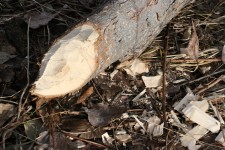The impact of humans on the landscape is undeniable but what other species significantly alters its environment to suit its need for food and shelter? The industrious beaver.
Beaver dams change the characteristics of a stream, including creating ponds, while the construction of lodges requires a significant quantity of trees from the nearby vicinity. The beaver’s impact on the land is evident long after the beaver moves away.
The sign of a busy beaver is easy to spot with their pencil-shaped stumps near a water’s edge. They can easily ‘log’ an entire area of cottonwood trees, which is evident on one of the islands upstream of Bonners Ferry. Beavers need an ample supply of trees to build their lodges and dams and to eat–practically everything they do is related to wood. They even need to gnaw on wood to wear down their continuously growing incisors.
Their favorite trees are aspen, cottonwood, birch and willow because of the nutritious inner bark. However, they will eat more nutritious plants if they are available, like pond lilies, sedges, grasses and berries. But during the winter, trees are the main menu item, just as they are for moose.
The beaver’s industrious nature pays off during the winter. Instead of felling trees as needed during the winter, they create rafts of wood during the summer to sustain themselves through the winter months. Beavers make a raft by floating branches in an area of their pond and then adding more branches underneath. They are known to start the raft with their least favorite tree species since those branches will become encased in the ice and then put the tastier branches underneath.
This raft strategy allows them to survive the winter easier. Beavers aren’t typically seen during the winter, not because they enter torpor or hibernation, but because they have everything they need in their lodge and pond. They only have to swim to their raft of wood to eat, which they do less often during the winter because they are less active. Besides that, they have warm fur, extra body fat and the ability to huddle with their beaver family to stay warm in their lodge.
Beaver lodges are an architectural work of art just like bird nests. While at first, the lodge may be a pile of sticks–from trees they felled and hauled there themselves–it becomes a lodge once the beaver gnaws away tunnels into the middle where they gnaw some more to create a nest chamber. The chamber is above the water surface, so depending on the depth of the pond the required number of sticks can be quite substantial. Then the beavers weather-seal the lodge with mud except for a small portion on top that remains open for air exchange.
Not all beavers build lodges, particularly if they live in rivers or large lakes. Instead, those beavers will build burrows in a bank or a combination of a burrow with a lodge at the entrance.
No matter where beavers live, they will be at work constantly during the ice-free months repairing their dams and lodges and building rafts for their winter food supply. Once they log all the preferred trees around their pond, they will leave their handiwork behind and find a new place to alter and leave their mark.

